January 31, 1980
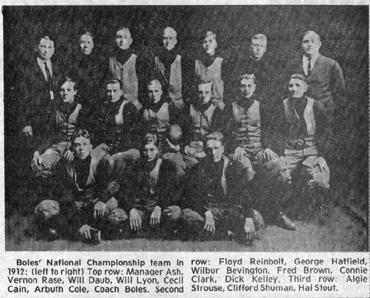
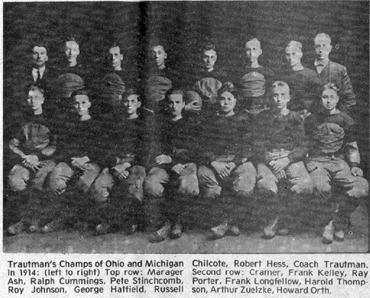
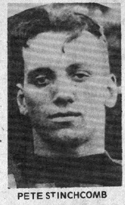
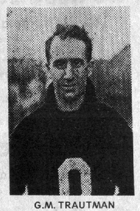
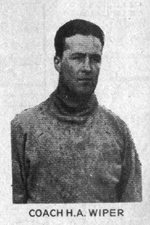
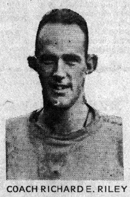
Picture #1 – Boles’ National Championship team in 1912: (left to right) Top row:
Manager Ash, Vernon Rase, Will Daub, Will Lyon, Cecil Cain, Arbuth Cole,
Coach Boles. Second row: Floyd Reinbolt, George Hatfield, Wilbur Bevington,
Fred Brown, Connie Clark, Dick Kelley. Third row: Algie Strouse, Clifford
Shuman, Hal Stout.
PIX #2 – Trautman’s Champs of Ohio and Michigan in 1914: (left to right)
Top row: Manager Ash, Ralph Cummings, Pete Stinchcomb, Roy Johnson, George
Hatfield, Russell Chilcote, Robert Hess, Coach Trautman. Second row:
Cramer, Frank Kelley, Ray Porter, Frank Longfellow, Harold Thompson, Arthur
Zuelzke, Howard Orth.
PIX #3 – Pete Stinchcomb
PIX #4 – G.M. Trautman
PIX #5 – Coach H.A. Wiper
PIX #6 – Coach Richard E. Riley
PIX #7 – Coach E.P. Weltner
(EDITOR’S NOTE: This is the second in a series of articles about football as it was played and won at FHS many years ago.
Coach Boles’ greatest year at Fostoria High was certainly 1912, when The Boston Transcript conceded that the Fostoria High football team was the best in the United States. Springfield had the best team in its history that year and Fostoria defeated them easily 41-0.
Then on Thanksgiving Day, always a great day for football in Fostoria, Buffalo Central High, the champions of New York State who had won the Vanderbilt Cup, came to town, expecting to continue their successful record. The local fans despaired for FHS because of Buffalo’s expertise with the forward pass and their fast handling of plays. Fostoria’s initial fears turned to joy when the score ended Fostoria 74 to Buffalo 0.
Coach Little, from University of Cincinnati, who officiated in several of the games in which Fostoria played, said he thought Fostoria had the forward-pass nearer perfection than any team he had ever seen, and that they could defeat the majority of the colleges in the state.
BOLES TO WOOSTER
Boles’ success at Fostoria was too much to hold him here, so in 1913 he accepted a coaching position at East Cleveland, and later went to Wooster College to headup all their athletics. He stayed at Wooster for the rest of his coaching career, and during that time attracted Fostorians there to participate in sports, including Bill Daub and Charles “Red” Forrest.
Boles retired as coach of Wooster in 1939, but became athletic director, a position he held until death in 1945.
1913 was a sad season for the Red and Black football team. Coach Loomis, following Boles, was unable to do much with his players and the season ended up with Fostoria losing many of its games, accumulating 131 points to 91 for the opponents.
OHIO-MICHIGAN CHAMPS
George “Red” Trautman, an Ohio State University graduate came to Fostoria in 1914 to turn things around. He was popular with the players and fans from the start. Fostoria beat Tiffin 112-0. Ann Arbor, the champions of Michigan, played here on Thanksgiving Day and FHS won easily. Having already won all of the Ohio games, Fostoria was acclaimed the champions of Ohio and Michigan. The season record was FHS 558 points to 16 for opponents.
Trautman stayed in Fostoria only two years, and during 1915 the Red and Black again became state champions, rolling up 299 points for the season against 21 for opponents. Trautman went from Fostoria to Ohio State to become physical director. Pete Stinchcomb, one of his star players here followed him there and became an All-American halfback, along with “Chick” Harley, the other halfback.
ROUGH YEARS
In 1916, Carl Peter, an old FHS star was hired as coach. It was a rough year for Fostoria who was only able to garner 109 points for the season against 69 for opponents. Fostoria’s record for that year was five wins, two loses, and one tie.
In 1917, Bill Gailey, YMCA physical director, was hired as coach. Harold Switzer, still living in Fostoria, was captain that year. Fostoria rolled up 414 points for the season to 51 for opponents.
Carl Peter was back as coach, assisted by Richard Kelley in 1918. It was the only year up to that time opponents were able to outscore the Red and Black team. The year ended Fostoria, 116 to 276 for opponents.
In addition to piling up mostly victories and winning scores, the Red and Black team members also established some individual feats during the period of 1897 through 1915. Here they are:
In 1909, in the game with Toledo, there, Harry Hoffmaster who was playing end for FHS, overtook Sala, Toledo’s 10-second man, after he had a 10-yard start and caught him before he crossed the goal line.
Carl Peter made a successful 50-yard forward-pass in the 1909 game with Findlay…further than many punters can kick.
In 1908, John Johnson, in practice, made a successful drop-kick of 60 yards. Had he done it in a game he would have beaten the record of the world’s greatest, Brickley.
George Hatfield won the trophy cup at the football tournament in Cleveland in 1914. Out of nine chances, three for each from the 20, 25 and 30 yard line, he did not miss a single attempt.
Hal Stout’s punts during the several seasons he was a member of the team averaged about 55 yards, but in the Findlay game in 1910, he kicked one for 85 yards, according to the old records.
Fostoria’s total scores for the years 1899-1914 wre 4521, opponents 309.
Fostoria had four teams, back then, that were never scored upon, 1903 with 182-0; 1905 with 192-0; 1906 with 333-0; and 1912 with 596-0.
EARLY PLAYERS
Earlier in this article I said that it was too bad space wouldn’t permit showing more pictures of the teams from the early days. To partially compensate for those omissions we are including a list of names of team members from 1897 through 1916 which are not listed with pictures shown. It will interest many readers.
Frank Bunce, Ed Flechtner, Harry Gardner, Jay Doke, Stanley Lovett, Alva Weaks, Fred Flechtner, Judd Asire, Otis Wickerd, Carl Smith, James Sellers, Gideon Hatfield, Charles “Bud” Friesner, Charles Morlock, Ed Wright, Charles Eshelman, Tal Cribbs, Randolph Long, Lee Harbaugh, Olie Binder, Pat Hilgerink, Nathan Hatfield.
Well Callin, Wayne Norris, Tom Norris, Curt Guernsey, Harry Mumma, John Johnston, Earl Rosendale, Harry Hoffmaster, Delbert Stevens, Byron Ralston, Will Maurer, Earl Fox, Leonard Reycraft, Carl Peter, Ross Kipka, Harry Harley, Karl Ghaster, James Gray, Floyd Smith, Charles Forrest, Kaye Berringer, Milo Norris.
Florentine Eckerle, Lon Emerine, Grover England, Will Daub, Maynard Norris, Virgil Hicks, Hal Stout, Wilbur Bevington, Duane Smothers, Cecil Cain, Clifford Shuman, Dick Kelley, Fred Brown, George Hatfield, Carl Sayre, Arbuth Cole, Algie Strouse, Harry Jackson, Carl Diver, Vernon Frase, Will Lyon, Connie Clark, Russell Chilcote, Pete Stinchcomb, Ed Cramer, Frank Longfellow, Harold Thompson, Gerald King, Floyd Smeltzer, Griswold Werner.
Ralph Cummings, Robert Hess, Frank Kelley, Ray Porter, Arthur Zuelzke, Howard Orth, Laurin Hawkins, Roy Johnston, Jay Schaffner, Kenneth Duffey, Norris Reed.
I could write separate paragraphs about many of the above…many of them went on to make names for themselves in their chosen professions.
1919 NEW OUTLOOK
1919 was a turning point from Fostoria’s unsuccessful years. “Smiley” Weltner arrived in Fostoria to be the coach and stayed for two years. The first year he found an abundance of material to work with and turned out a fine team, captained by Elwood Fox, fullback, and Bill Foster and Harold Worley as halfbacks. The season ended with Fostoria’s scoring record 374 points to 35 for opponents.
In his second and final year, 1920, Weltner guided FHS to the Northwestern Ohio Championship, making 384 points for the season to 13 for opponents.
It was during Weltner’s regime that enthusiasm ran high in the school and among local fans for the football team. Wainwright was in Fostoria and had the new band functioning and had written the football fight-song. Pep rallies were held before each game and during weekly chapel sessions.
Harold Wiper became coach in 1921 and had a successful season, scoring 262 points against opponents 46.
During Wiper’s second and final year in Fostoria only two opponents, Lima Central and Hicksville, were able to score six points each, and Fostoria finished the season with 427 points.
I’ll write more about Fostoria and St. Wendelin football at a later date.